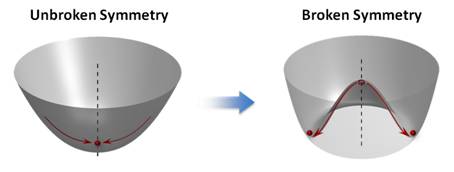Peking University, Jan. 19, 2017: Symmetry is the essential basis of nature, which gives rise to conservation laws. In comparison, the breaking of the symmetry is also indispensable for many phase transitions and nonreciprocal processes. Among various symmetry breaking phenomena, spontaneous symmetry breaking lies at the heart of many fascinating and fundamental properties of nature.
Very recently, for the first time, a team led by Professor Xiao Yun-Feng at Peking University (China), collaborated with University of Science and Technology of China, Hunan Normal University (China) and the City University of New York (USA), proposes and demonstrates experimentally the emergence of spontaneous symmetry breaking in an ultrahigh-Q whispering-gallery microresonator. This work has been published in the recent issue of Physical Review Letters [Q.-T. Cao et al., Phys. Rev. Lett. 118, 033901 (2017)].
Spontaneous symmetry breaking describes a phenomenon where physical states violate the underlying in variance of the system, which has been being concerned in diverse fields, such as, Higgs physics, Bose-Einstein condensates, and superconducting. Meanwhile, spontaneous symmetry breaking in an optical system also holds great potential for the study of fundamental physics and high-performance photonic devices, which, however, is seldom realized.
In this work, the researchers have observed spontaneous symmetry breaking in an optical whispering gallery microcavity. The whispering gallery modes are analogous to the acoustic resonances in the whispering gallery in St. Paul Cathedral in London and the echo wall in the Temple of Heaven in Beijing. Due to the low propagation loss and the small size of such microcavities, where photons can circulate inside for up to millions of times, light-matter interactions are thus dramatically enhanced. Importantly, such a whispering gallery microresonator possesses the intrinsic rotation symmetry, and supports two degenerate propagating-wave modes: clockwise (CW) and counterclockwise (CCW) waves, manifesting the symmetry of this system.

Figure 2: Mode patterns before and after the spontaneous symmetry breaking.
In this work, the physicistsapplythe optical Kerr effect of the resonator to induce the spontaneous symmetry breaking, where the change of the refractive index is proportional to the intensity of light. “The Kerr effect provides a nonlinear coupling between the CW and CCW waves, which depends on the input power,” said Heming Wang, who was an undergraduate at Peking University and now is a Ph.D. student at California Institute of Technology. “When the power reaches a threshold, the total coupling strength of the two propagating waves is modulated to zero due to the coherent nonlinear cross-mode effects, so that the original state with balanced CW and CCW components becomes unstable and then spontaneously transfers to the symmetry-breaking regime.”
In the experiment, a whispering gallery mode with an ultra-high Q factor of a circular silica microresonator is excited. “To ensure the intrinsic symmetry of the system, we use the bi-directional inputs with the identical power and polarization, resulting in the balanced intensities of CW and CCW emissions at very weak input power,” said Cao Qi-Tao, a Ph.D. student at Peking University. When the input power is above a threshold of a few hundred microwatts, the symmetry of CW and CCW waves was spontaneously broken with a dominant wave propagating in either the CW or the CCW direction. “Note that the original state would randomly enter the two symmetry-breaking states, and the CW-to-CCW output ratio could exceed 20:1,” said Cao.
"This experimental realization of spontaneous symmetry breaking in an optical microcavity offers a promising platform for optical simulations of related physics,” said Prof. Xiao. “Furthermore, not only does such spontaneous symmetry breakingprovide a new means to manipulate light on the chip scale,but also the underlying mechanism can be applied to acoustic waves, microwaves, and nonlinear dynamical systems in general.”
More information: Qi-Tao Cao et al. Experimental demonstration of spontaneous chirality in a nonlinear microresonator, Physical Review Letters 118, 033901 (2017).
Edited by: Zhang Jiang
Source: School of Physics















